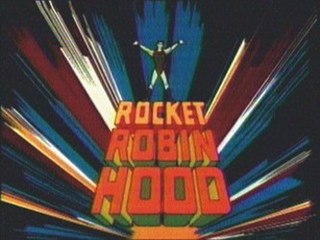
Rocket Robin Hood is a Canadian animated television series, placing the characters and conflicts of the classic Robin Hood legend in a futuristic, outer space setting. It was produced by Krantz Films, Inc. and aired on CBC Television from 1966 to 1969.
Where's Huddles? is an American animated sitcom produced by Hanna-Barbera Productions that premiered on CBS on July 1, 1970. It ran for ten episodes as a summer replacement show for Hee Haw, until September 2.
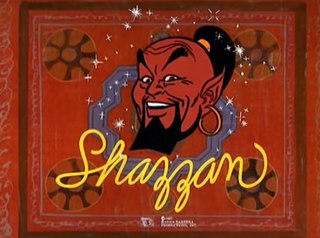
Shazzan is an American animated television series created by Alex Toth and produced by Hanna-Barbera Productions that aired on Saturday mornings on CBS from September 9, 1967, to January 20, 1968, and continued in reruns until September 6, 1969. The series follows the adventures of two teenage siblings, Chuck and Nancy, traveling around a mystical Arabian world, mounted on Kaboobie the flying camel. During their journey they face several dangers, but they are aided by Shazzan, a genie with magical powers. 18 half-hour episodes were produced, made up of two 11-minute segments.

Clutch Cargo is an American animated television series created by cartoonist Clark Haas and produced by Cambria Productions, syndicated beginning on March 9, 1959. The series was notable for its limited animation yet imaginative stories, as well as for being the first widely-known use of Syncro-Vox technology.
Syncro-Vox is a filming method that combines static images with moving images, the most common use of which is to superimpose talking lips on a photograph of a celebrity or a cartoon drawing. It is one of the most extreme examples of the cost-cutting strategy of limited animation. The method was developed by cameraman Edwin "Ted" Gillette in the 1950s in order to simulate talking animals in television commercials. Gillette filed the technique on February 4, 1952, and obtained patent #2,739,505 on March 27, 1956.

Space Ghost is an American Saturday morning superhero animated television series produced by Hanna-Barbera Productions, first broadcast on CBS from September 10, 1966, to September 16, 1967, and continued reruns until September 7, 1968. The series was composed of two unrelated segments, Space Ghost and Dino Boy in the Lost Valley. The series was created by Alex Toth and produced and directed by William Hanna and Joseph Barbera. Sometimes, it is alternatively called Space Ghost & Dino Boy to acknowledge the presence of both shows.
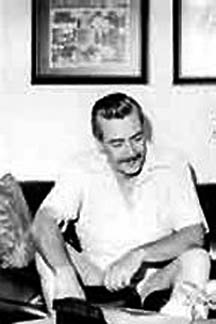
Chester Warren Tufts, best known as Warren Tufts, was an American comic strip and comic book artist-writer best known for his syndicated Western adventure strip Casey Ruggles, which ran from 1949 to 1954.
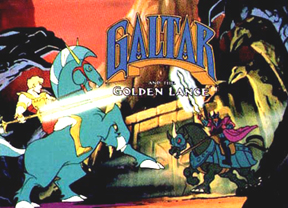
Galtar and the Golden Lance is a 30-minute animated sword and sorcery television series produced by Hanna-Barbera Productions, which aired in syndication in 1985–86 as part of The Funtastic World of Hanna-Barbera. The show ran for 21 episodes and is thought to have been created due to the rising popularity of the He-Man franchise.
Luno the White Stallion is a Terrytoons cartoon character active from 1963 to 1965. The series of cartoons centered on a little boy named Tim who had a toy horse of marble white named Luno, who would come alive and whisk him off on adventures in far off lands when Tim said the words, "Oh winged horse of marble white, take me on a magic flight". The series was produced by William Weiss, and directed by Connie Rasinski and Arthur Bartsch.
Edwin Gillette was a cameraman and inventor notable for the development of the Syncro-Vox technique of limited animation, which was used in the series Clutch Cargo.
Cambria Productions was the West Hollywood, California animation production studio most famous for its wide usage of the Syncro-Vox technique of animation developed by Edwin Gillette, who was a co-partner in the studio.
Clark S. Haas, Jr. was a cartoonist and, from 1957 to 1965, owner of Cambria Studios, which produced the limited animation series Clutch Cargo (1959).

Gilligan's Planet is an American Saturday morning animated series produced by Filmation and MGM/UA Television which aired during the 1982–1983 season on CBS. It was the second animated spin-off of the sitcom Gilligan's Island.

Space Angel is an animated science fiction television series produced in the United States from early 1962 through 1964. It used the same Synchro-Vox lip technique as Clutch Cargo, the first cartoon produced by the same studio, Cambria Productions. The show was created by Dick Darley, who also created the 1950–1955 live-action series Space Patrol.
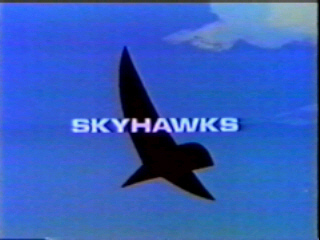
Skyhawks was a 17-episode television cartoon series sponsored by Mattel Toys. Each half-hour episode consisted of two adventures. The series originally aired from September 6, 1969 to September 4, 1971 on ABC. It was a Pantomime Picture Production and is distributed by CBS Television Distribution.
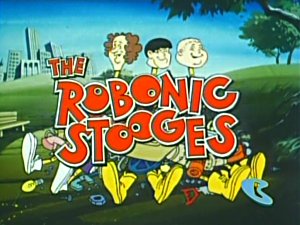
The Robonic Stooges is a Saturday morning animated series featuring the characters of The Three Stooges in new roles as clumsy crime-fighting cyborg superheroes. It was developed by Norman Maurer and produced by Hanna-Barbera Productions from September 10, 1977, to March 18, 1978, on CBS and contained two segments: The Robonic Stooges and Woofer & Wimper, Dog Detectives.
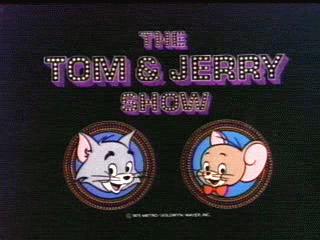
The Tom & Jerry Show is an American animated television series produced by Hanna-Barbera Productions in association with MGM Television. Based on the Tom and Jerry theatrical cartoon series, which was created by H-B co-founders and former MGM cartoon studio staff William Hanna and Joseph Barbera, the show originally aired on ABC from September 6 to December 13, 1975 as the first half of The Tom and Jerry/Grape Ape/Mumbly Show, with The Great Grape Ape Show representing the series' second half and The Mumbly Cartoon Show representing the series' third half. This series marked the first time that Tom and Jerry appeared in animated installments produced specifically for television.
The Adventures of Spunky and Tadpole is an animated television series produced by Beverly Hills Productions and syndicated beginning on September 6, 1958. The show's characters were a boy and a bear who hunted down bad guys. The show was made in three and a half-minute episodes, with ten parts comprising each story. It was most frequently shown one episode a day as part of a local station's afternoon children's programming. The show remained in production until 1961.

Adventures of Pow Wow is an American animated cartoon that was broadcast on the Captain Kangaroo show during the 1950s. The series is in the public domain due to failure to renew copyright.
The Space Kidettes is an American Saturday morning animated television series produced by Hanna-Barbera Productions, originally airing on NBC during the 1966–67 season. In the show, junior rangers Snoopy, Jenny, Countdown and Scooter patrol the cosmos from their space-capsule clubhouse, with help from their dog Pupstar. Twenty episodes were produced.











